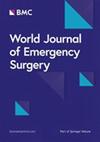Primary closure and prophylactic antibiotics for treatment of traumatic wounds caused by mammals, a systematic review and meta-analysis
IF 5.8
1区 医学
Q1 EMERGENCY MEDICINE
引用次数: 0
Abstract
To compare primary closure (PC) with delayed/no closure (DC/NC), and compare prophylactic use of antibiotics (PUA) with no use of antibiotics (NUA) in the treatment of traumatic wounds caused by mammals by a systematic review and meta-analysis. PubMed and Embase databases were searched for eligible randomized clinical trials (RCTs) and observational studies. Qualities of RCTs were assessed according to Cochrane risk of bias tool, qualities of observational studies were assessed according to Newcastle–Ottawa Scale. Primary outcomes included the incidence of wound infection or poor wound healing and the rate of wound cosmesis satisfaction. The relative risks (RRs) of RCTs, odds ratios (ORs) of observational studies and their 95% confidence interval (CI) were extracted directly from included studies or calculated according to the 2 × 2 table obtained by the incidence. The sensitivity analysis, meta-regression and subgroup analysis were performed to identify clinical factors that caused the heterogeneity between studies. Of 26 included studies, 17 studies (8 RCTs and 9 observational studies, 8091 patients) compared PC with DC/NC and 14 studies (7 RCTs and 7 observational studies, 2508 patients) compared PUA with NUA. The pooled OR of all studies (PC versus DC/NC) for wound infection or poor wound healing was 0.79 (95%CI: 0.54, 1.17), the pooled RR of RCTs for wound infection was 0.73 (0.51, 1.06). The pooled OR for cosmesis satisfaction was 3.68 (1.27, 10.68) of 2 studies (PC versus DC) that did not use the negative pressure sealing drainage technique. Subgroup analysis demonstrated that the pooled OR was significant under specific clinical conditions: (1) comparison of PC and DC (pooled OR: 0.49 [0.27, 0.90]), (2) prophylactic use of antibiotics (0.56 [0.33, 0.94]), (3) no use of antibiotics (0.63 [0.41, 0.98]), (4) wounds located in limbs/trunk (0.41 [0.23, 0.73]), (5) time to the first medical presentation (TTP) ≤ 10 h (0.59 [0.39, 0.89]). While the pooled OR (PC versus NC) was not significant (0.84 [0.51, 1.37]). The pooled OR of all studies for wound infection (PUA versus NUA) was 0.73 (95%CI: 0.46, 1.17), the pooled RR of RCTs for wound infection was 0.81 (0.46, 1.44). No included studies (PUA versus NUA) reported the outcome of wound cosmesis. Subgroup analysis demonstrated that the pooled OR was significant under specific clinical conditions: (1) injury caused by other type of mammals other than dog (pooled OR: 0.24 [0.06–0.98]), (2) wounds located in face/head (0.13 [0.03, 0.52]). Regardless of whether prophylactic antibiotics are used or not, compared to delayed closure, primary closure should be given priority in treating traumatic wounds caused by mammals which can decrease the incidence of wound infection or poor wound healing and obtain the better wound cosmesis, but it does not show the superiority compared to no closure, unless under some specific clinical conditions. Prophylactic use of antibiotics may not benefit in prevention of wound infection unless under specific clinical conditions, such as wounds caused by mammals other than dogs or wounds located in face/head.初步封闭和预防性抗生素治疗哺乳动物造成的创伤,系统回顾和荟萃分析
通过系统综述和meta分析,比较初次缝合(PC)与延迟/无缝合(DC/NC),比较预防性使用抗生素(PUA)与不使用抗生素(NUA)治疗哺乳动物创伤性伤口的效果。检索PubMed和Embase数据库,查找符合条件的随机临床试验(rct)和观察性研究。随机对照试验质量采用Cochrane偏倚风险评估工具评估,观察性研究质量采用Newcastle-Ottawa量表评估。主要结局包括伤口感染或愈合不良的发生率和伤口美容的满意率。rct的相对危险度(RRs)、观察性研究的优势比(ORs)及其95%置信区间(CI)直接从纳入的研究中提取或根据发病率得到的2 × 2表计算。通过敏感性分析、meta回归和亚组分析确定导致研究间异质性的临床因素。在纳入的26项研究中,17项研究(8项随机对照试验和9项观察性研究,8091例患者)比较了PC与DC/NC, 14项研究(7项随机对照试验和7项观察性研究,2508例患者)比较了PUA与NUA。所有研究(PC vs DC/NC)伤口感染或伤口愈合不良的合并OR为0.79 (95%CI: 0.54, 1.17),伤口感染的rct合并RR为0.73(0.51,1.06)。未使用负压密封引流技术的2项研究(PC与DC)美容满意度的综合OR为3.68(1.27,10.68)。亚组分析显示,在特定的临床条件下,汇总OR (1) PC与DC的比较(汇总OR: 0.49[0.27, 0.90]),(2)预防性使用抗生素(0.56[0.33,0.94]),(3)未使用抗生素(0.63[0.41,0.98]),(4)肢体/躯干伤口(0.41[0.23,0.73]),(5)首次就诊时间(TTP)≤10 h(0.59[0.39, 0.89])。而合并OR (PC vs NC)不显著(0.84[0.51,1.37])。所有伤口感染研究(PUA vs NUA)的合并OR为0.73 (95%CI: 0.46, 1.17),伤口感染的rct合并RR为0.81(0.46,1.44)。没有纳入的研究(PUA与NUA)报道伤口美容的结果。亚组分析表明,在特定的临床条件下,混合OR具有显著性:(1)除狗以外的其他哺乳动物造成的损伤(混合OR: 0.24[0.06-0.98]),(2)面部/头部损伤(0.13[0.03,0.52])。无论是否使用预防性抗生素,在哺乳动物创伤性创面治疗中,与延迟缝合相比,应优先考虑一次缝合,可减少创面感染或愈合不良的发生率,获得更好的创面美容效果,但除非在某些特定的临床条件下,与不缝合相比并不表现出优势。预防性使用抗生素可能不利于预防伤口感染,除非在特定的临床条件下,例如由除狗以外的哺乳动物造成的伤口或位于面部/头部的伤口。
本文章由计算机程序翻译,如有差异,请以英文原文为准。
求助全文
约1分钟内获得全文
求助全文
来源期刊

World Journal of Emergency Surgery
EMERGENCY MEDICINE-SURGERY
CiteScore
14.50
自引率
5.00%
发文量
60
审稿时长
10 weeks
期刊介绍:
The World Journal of Emergency Surgery is an open access, peer-reviewed journal covering all facets of clinical and basic research in traumatic and non-traumatic emergency surgery and related fields. Topics include emergency surgery, acute care surgery, trauma surgery, intensive care, trauma management, and resuscitation, among others.
 求助内容:
求助内容: 应助结果提醒方式:
应助结果提醒方式:


